September 2011
Sometimes it doesn't take much to nudge one's life in a little different direction, and for this direction to then blossom into a career and decades of delights working in the computer industry.
Probably sometime around 1969 — when I was 16 years old — I bought an album entitled Switched-On Bach by Walter (later, Wendy) Carlos and Benjamin Folkman, which had been released the previous year. I wasn't unusual in this respect. Many people bought this album. It was one of the best-selling classical albums of all time and it received three Grammy Awards.
Switched-On Bach consists of several compositions by Johann Sebastian Bach (1685–1750) played on a Moog electronic music synthesizer, including a complete Brandenburg Concerto No. 3 with a spacey middle movement composed by Carlos and Folkman for the recording. I must have read some articles about the album because it was very clear to me how it was made: Although the Moog synthesizer had a keyboard, it was essentially monophonic, so each melodic line had to be recorded separately on a multitrack tape recorder.
Switched-On Bach was an important event in my life. I loved the music, and it initiated an interest in classical music that led to a collection of about 1,200 classical LPs by the early 1980s, eventually to be replaced with a current collection of well over a thousand classical CDs.
But I also knew that I wanted to make electronic music myself. I didn't grow up in a household with musical instruments (apart from my mother's old accordion in the closet) and although I could read music — apparently I picked it up in some "music appreciation" course and never lost it — I couldn't play anything. Nevertheless, tunes of my own invention would often rattle around in my head. I wanted to hear them for real, and realizing them using electronic music seemed ideal.
This is the story of how I eventually built my own electronic music instruments while teaching myself digital electronics, computer hardware, and assembly language programming. Roughly between the mid-1970s and the mid-1980s, this hobby (and it was never really more than a hobby) led directly to my being able to write assembly language programs for the IBM PC in the early 1980s, which led to my career at PC Magazine beginning in 1984, which led to the rest of my career. This hobby also gave me the background knowledge and understanding to write the book Code: The Hidden Language of Computer Hardware and Software (1999).
Several years ago, when Programming in the Key of C#: A Primer for Aspiring Programmers was being published, I wanted to dedicate the book to Wendy Carlos and Bach, but the page count was such that there was no room for a dedication page. Instead, I included this paragraph in the Prelude:
I feel I owe a huge part of the arc of my professional life to Wendy Carlos, whose 1968 album Switched-on Bach introduced an inquisitive 16 year old not only to the music of Bach, but also to the technology of electronic music. A decade later, I was teaching myself digital electronics, building my own computer-controlled electronic music instruments, and slowly convincing myself I had more talent with chips and code than with composing music. I hope the program in the last chapter of this book will be accepted as an homage to Wendy Carlos and the Switched-On Bach tradition.
That my talents do not lie in music composition will be confirmed by the many audio files I've recently created from my old tapes and which are playable from this page.
My First Keyboard
In the summer of 1972 between my freshman and sophomore years attending Stevens Institute of Technology, I got my first job: I was a busboy at the Cafe Contempo in Stern's Department Store in the Woodbridge Center shopping mall near my home in New Jersey. This job was specifically for the purpose of earning enough money to buy a $500 Univox electronic piano.
I say electronic piano rather than electric piano because electric pianos (like the Fender Rhodes) contain actual hammers striking wires or metal objects. My Univox was an electronic piano, which produced sound entirely through electronic components, much like an electronic organ. It had five octaves (61 keys), and a foot pedal for sustain. Inside was a long circuit board, containing 61 separate oscillators that produced a tone somewhere between a piano and a harpsichord but not as pleasant as either. Each key was basically a switch that moved a little flexible spring in contact with a U-shaped piece of thick wire.
I took the piano back to college in my sophomore year. I had a private dorm room and headphones (as well as a big guitar amp), so I could play it without disturbing anyone, and I taught myself a little piano. My early repertoire consisted of the first movement of Beethoven's Moonlight Sonata, Scott Joplin's Magnetic Rag, some easy Bach from the Notebook of Anna Magdalena, some stabs at the Two-Part Inventions, and bits and pieces of some Debussy Preludes.
Building the Studio
When I turned 21 in February 1974, I came into some money from a trust fund. Most of the money had already gone to fund my college education, and when I allocated enough for my final three semesters, I had about $3,000 left.
This was just enough money to turn a dormitory room into a beginner's electronic-music studio. In early September 1974, I went to one of the famous New York City music stores on 48th Street in Manhattan (either Sam Ash or Manny's) and bought two essential items:
- an EML ElectroComp 101 synthesizer; and
- a Teac 3340S reel-to-reel tape recorder.
Here's an ad that I snagged from the SynthMuseum web site:
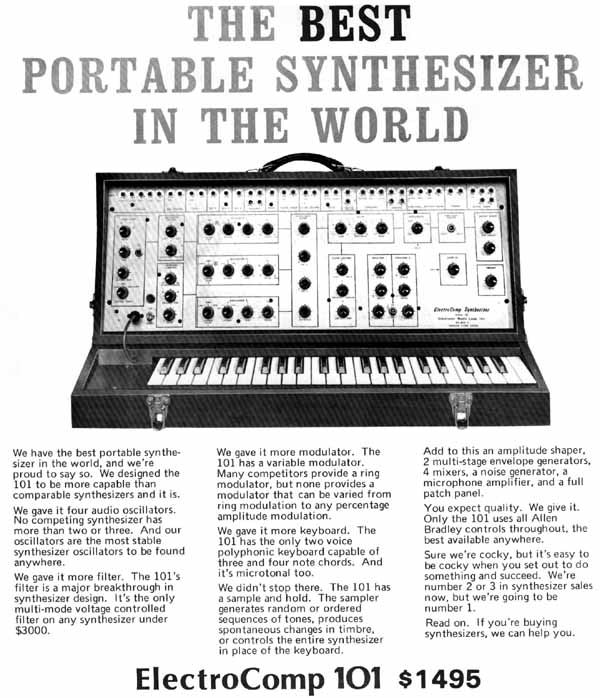
The 3½ octave keyboard was typical of synthesizers in this price range. I was actually intending to buy a Minimoog (which was about the same price) but after playing around with the ElectroComp I realized that the plugboard along the top could be used for some interesting techniques. The Minimoog was a nice little instrument, but I never regretted my choice.
I believe the Teac 3340S cost about $1,200:
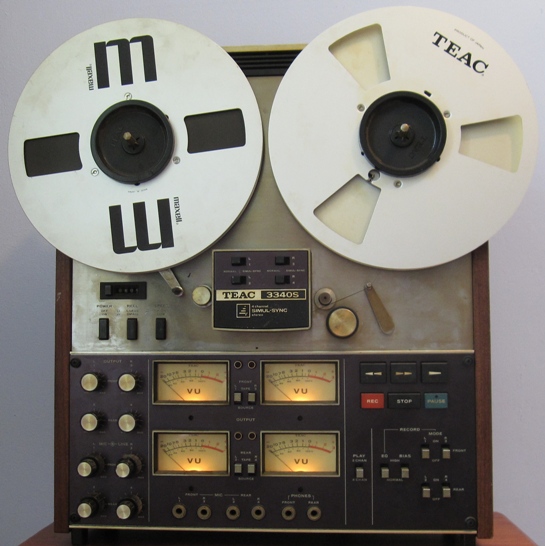
This was a very popular tape deck for home studies, and it had several important features. Most consumer reel-to-reel tape decks — and in the 1960s and even into the 1970s, their presence meant that you were in the home of an audiophile — ran at 3¾ and 7½ inches per second (ips). The Teac 3340S supported 7½ and 15 ips. Consumer tape decks used 7-inch reels. The Teach 3340S was roomy enough to use 10½-inch reels. Consumer tape decks recorded and played back in stereo: two tracks going one way on the ¼-inch tape, and two tracks going the other way (just like cassette tapes). The Teac 3340S supported a four-track mode to use the full width of the tape in one direction.
By 1974, professional music studios had moved far beyond four-track recording, so those of us building home (or in my case, dormitory) studios around four-track tape decks would often need to remind ourselves that Sgt. Pepper was recorded on four-track machines.
According to the Wikipedia entry for Tomita's 1974 album Snowflakes are Dancing, he used a Teac 3340S but only in conjunction with other equipment, including a 16-track Ampex deck.
Analog Basics
The 1960s and early 1970s was the era of analog synthesizers built pretty much entirely from resistors, capactors, transistors, wire, and solder. The circuitry that actually made the sounds was called a voltage-controlled oscillators (VCO), which meant that the frequency of the waveform generated by the oscillator was proportional to an input voltage — or rather, exponentially proportional to the voltage. Most commonly a 1-volt increase raised the frequency by an octave. For example, if a 5-volt input caused the VCO to generate a waveform at Middle-C or 261.63 cycles per second, a 6-volt input would generate the C one octave higher, or 523.251 Hertz.
This exponential relationship between voltage and frequency meant that you could actually control it from an organ-type keyboard. The first person to attach a keyboard to a voltage-controlled oscillator was Robert Moog (1934–2005) in the early 1960s. Electronic music synthesis had existed prior to that time, but the keyboard really made it user-friendly to composers and musicians.
The synthesizer keyboard is basically a voltage divider: A 5-octave keyboard, for example, contains a string of 60 resistors of the same value wired in series. Put a voltage at one end and a ground at the other. Each key taps a spot between two resistors, and the voltage at that point is output from the keyboard.
This design meant that the keyboard were monophonic. They only output one voltage. If you tried playing a chord on the keyboard, the output voltage was based on the highest key and the others would be ignored. But even if the keyboard was able to output multiple voltages, there wasn't much you could do with all that information. Small synthesizers contained just a few VCOs. The ElectroComp 101 had four. But even larger synthesizers wouldn't try to have a bunch of VCOs playing at once. These were analog components, they were affected by heat, and one of the big challenges was just keeping them in tune.
There were some keyboards (like the ElectroComp 101) that output two voltages, one from the highest key and one from the lowest. This allowed you to control two VCOs playing separate notes, but I never found that this worked very well because pressing only one key in this mode would cause both VCOs to be based on that key, which sounded different from a single VCO.
VCOs were capable of generating sine waves, but sine waves by themselves are rather boring and lifeless. You really need a lot of sine waves to start sounding like real sounds, and you couldn't do that because you couldn't keep that many VCOs in tune. It was much more common for VCOs to generate simple waveforms rich in harmonics, like square waves, and triangle waves, and sawtooth waves. Those were the biggies. Square waves sounded kind of woody, like a clarinet or oboe, while sawtooth waves sounded more like string instruments like the violin.
As you press and release a key on the keyboard, you don't want to just turn on the VCO and then turn it off. That would sound too mechanical. Instead, when you press a key on the keyboard, you want the sound to rise in volume (called the "attack") and then decline a bit (the "decay") and then keep at a level while you hold the key (the "sustain"). When you release the key, you want to volume to decrease down to zero (called the "decay"). This combination of attack, sustain, decay, release is known as an "envelope," so to produce decent sounds, the synthesizer contains envelope generators triggered by the pressing and releasing of the keys. These envelope generators output voltages to voltage-controlled amplifiers or VCAs that modify the volume from the VCOs.
But even this isn't enough. You really want the quality or timbre of each note to change over its duration, so instead of a note sounding like BHHHHH it sounds more like BHWOUP. Even if the note is only a tenth second in duration, this makes a big difference. To make the sound change in quality over its duration, you run the output from the voltage-controlled oscillator into a voltage-controlled filter (or VCF), and then run the output from that into the voltage-controlled amplifier. This VCF is also controlled from an envelope generator and attenuates some of the harmonics of the harmonically-rich waveform output from the VCO. (You can also run an envelope generator into the VCO so the frequency of the note changes over its duration.)
This attentuation of harmonics from square waves or sawtooth waves is why analog synthesis of this type is sometimes called "subtractive" synthesis. You begin with a waveform with lots of harmonics, and then you remove some. Opposite to this is "additive" synthesis, in which a complex waveform is built from sine waves, but this is a more complex technique.
When you're using one of these synthesizers, you set it up with one of more VCOs, VCFs, and VCAs controlled by envelope generators to produce a particular quality of sound. This combination of settings is known as a "patch" even if everything is done with knobs rather than actual patch cords. Then you record a track on the tape recorder and when you're done with that patch, you set up the synthesizer with another patch.
When creating music in this way on a four-track tape deck like the Teac 3340S, you're recording on a single track at a time, and you need to listen to what you've already recorded on the previous tracks. The Teac 3340S allows this: Each of the four tracks can be independently selected for recording, and independently selected for listening to what's on the tape, or the signal that's coming into the tape deck.
If you're creating a composition that has any notion of a beat, one of the first things you do is lay down a "click track." This is one track that sounds like the click-click-click of a metronome. (Bach was a favorite composer to realize in synthesis partially because his music sounds good when played at a constant tempo, and that made the click track easy. Mahler, for example, would be much more problematic because you'd have to establish all the tempo changes for this click track. Tomita's synthesis of Debussy music in 1974 was particularly daring.)
You can then listen to that click track on Track 1 while recording some music on Track 2. Then you can listen to Track 1 and Track 2 while recording some more music on Track 3. Then you can record on Track 4, and by this time you probably don't need the click track any more, so you can record something else on Track 1. The result is four tracks all independently recorded.
Like all decent tape decks of this period, the Teac 3340S had separate playback and record heads. Actually, it has three sets of four-track heads. From left to right, the tape passes an erase head for erasing prior to recording, a record head, and a playback head. And this is a problem, because if you're listening to previous tracks through the playback head, and recording through the record head, the tracks will be out of sync. The record and playback heads in the Teac 3340S are separated by about an inch, so at a tape speed of 15 ips, the difference would be a very noticeable.
Obviously the people at Teac were aware of this problem, and that's why the Teac 3340S has a feature they called Simul-Sync. By flipping switches located right on the box that covers the heads, you can switch the record head for any channel temporary into a playback head.
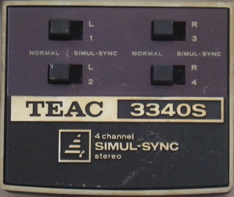
The playback qualities suffers, but you're only using it to keep in synchronization with the previous tracks. On top of everything else in the Teac 3340S, Simul-Sync is the essential feature for multi-track electronic music composition.
If you need more than four tracks and you only have one four-track tape deck, you can use a technique called "ping-ponging." In the example above, once you finish recording on Track 4, you can mix Tracks 2, 3, and 4 and record that back to Track 1. This frees up Tracks 2, 3, and 4, which you can then use for more stuff. This technique can be continued indefinitely, but sound quality suffers if it's repeated too much.
Finally, I don't think anybody really talked about it much, but everybody working with synthesizers and tape decks discovered a very simple but powerful technique: If you record something an octave lower at a tape speed of 7½ ips, you can play it back at 15 ips, and it sounds like you can play a lot faster than you really can.
My Mid-Seventies Music Scene
I no longer own the Electrocomp 101 synthesizer. Sometime in the mid-1990s I sold it to a little store on Mercer Street in Manhattan that sold vintage electronic music and recording equipment.
But I recently dragged the Teac 3340S out of storage, cleaned it up a bit, took the back off, sprayed some contact cleaner into the poteniometers and switches, mounted my old tapes, and discovered that it still worked fine after 35 years. All the tapes have now been converted to audio files for your listening — I was about to say "pleasure" but that's definitely the wrong word.
Most of what I had on tape from the period 1974 to early 1977 is either Bach or my own experimentations. My own stuff is obviously of the Ross Geller school of composition. (If you're fortunately not familiar with the sitcom Friends, Ross Geller's artistic passion is the synthesizer compositions that he plays with pretentious flair, embarassing everyone who hears them.)
The first piece I recorded using the ElectroComp 101 and the Teac 3340S tape deck is named simply Composition and is dated September 19, 1974. Obviously I was mostly playing around exploring what the synthesizer could do, but I also detect a motif or two.
Composition 9/19/74 (2:14)
A day later, my first attempt at a Bach piece made me appreciate more than ever the skill behind the creation of Switched-On Bach. Even playing it at half speed, I couldn't get the timing right. I did manage to slow down at the end, however.
Bach: Two-Part Invention in B♭ Major (1:28)
On September 21, 1974, an acquaintance named Joe Terlizzi came by my dormitory and we did a synthesizer realization of a little string quartet he had written. If he ever discovers this site and gives me permission to post the result, I will do so.
ADDENDUM: In February 2025, I received an email from Joe Terlizzi, who hasn't heard this recording in over 50 years, but who nevertheless gave me permission to post it. He has continued to compose music using GarageBand and his more recent music is available for streaming on Spotify, Amazon, and Apple Music. Here is that String Quartet from our college days:
Joe Terlizzi: String Quartet (1:57)
Five days later, I tried another Bach Two-Part Invention. This one starts off much stronger and punchier than my first attempt, but then it collapses with just too many timing problems, and whatever it was that I did in the last bar, it's obviously not what Bach composed.
Bach: Two-Part Invention in E♭ Major (1:54)
A day later, I tackled another one. As with the others, all I can hear are the mistakes, including spots where the recording cuts off for some reason.
Bach: Two-Part Invention in A Minor (1:34)
The next day, I taped another "composition." (This was September of my Senior year in college. Didn't I have any actual schoolwork to do?)
Variations on E♭, 9/28/74 (2:55)
I was taping these pieces on a 7-inch reel labeled as providing 60 minutes in each direction, or 2 hours total, but that's for a recording speed of 3¾ ips. I was recording at 15 ips and using all four tracks, which meant I couldn't use the other direction. The tape really provided only 15 minutes, and it was nearly full. I decided to use up the rest of the tape doing stuff where it wouldn't matter if the tape happened to run out (which it does).
Study, 10/2/74 (2:10)
I guess I figured that after a month of experimenting, and in celebration of starting another "60 minute" tape, I was ready to tackle something big, and by big in the Bach world we mean a Brandenburg Concerto. This is the first movement of Bach's Brandenburg Concerto No. 2, which took about three weeks and was finished in early November 1974.
Bach: Brandenburg Concerto No. 2, 1st movement (4:55)
I believe this is the only time I used ping-ponging. I'm not sure how much was involved, but the sound density is still pretty impressive, although the overall performance is not.
The experience must have had at least one benefit: When I tried another Bach Invention on November 24 — and perhaps significantly one that I could almost play for real at full speed with two hands on the Univox piano — it didn't come out too shabbily.
Bach: Two-Part Invention in C Major (1:07)
On December 8, 1974, my friend Steve Rounds came over and we put down a little composition he had written with my synthesizer in mind. It's a pretty little piece with lots of atmosphere and some interesting effects, but I'm not sure I could do it justice even if he gave me permission to post it. I remember when we mixed it down to cassette, he was fiddling with the volume controls like crazy to get the balances right.
It was winter vacation, and I dragged my equipment to my mother's house. In the two days after Christmas, I tried some more Bach.
Bach: Little Fugue in G Minor (2:37)
On January 12, 1975, I tackled one of the Bach three-part Inventions:
Bach: Three-Part Invention in B Minor (1:32)
On the same day I finished the second tape with another "composition" that I labeled on the tape as "improvised" as if the previous ones were not!
Composition, 1/12/75 (1:00)
A month later, on Tape No. 3, I did another. One of the big differences with this one (aside from the length) is that I also used the Univox electronic piano. It's the fuzzy harpsichordy polyphonic sounding thing. I'm not sure whether the stuff at the end was accidental or deliberate.
Composition, 2/12/75 (5:55)
And then I put something down on tape to which I assigned an actual title. An echo effect is easy with a tape recorder: As you're taping you run the output from the playback head back into the record head. I taped it at 7½ ips for playback at that speed; at 15 ips the echo is too fast.
Fantasy in Echo, 3/26/75 (6:04)
Almost a year passed, during which I graduated college, got a job at New York Life Insurance Company as an Actuarial Student, and moved to a studio apartment in New York City.
When I came back to the piano, synthesizer, and tape deck, I recorded another composition with a real title of sorts. I got the effect you hear at the beginning by setting up the synthesizer to trigger an envelope repeatedly, and then ran the piano through the synthesizer, and tried to play in synchronization with it.
Thing with Piano, February 1976 (7:08)
Nine months passed. In November 1976, I began a composition that I never finished and should have erased, I tried a couple pop songs (unsuccessfully), and then demonstrated complete disrespect by attempting a synthesizer rendition of part of one of Bach's greatest works. The glissando effects near the end are deliberate but I didn't get the rhythm quite right. (The glissando is supposed to end on the beat.)
Bach: Goldberg Variations: Variation No. 1 (1:05)
On Bach's birthday in 1977, I concluded the third tape (this one "90 minutes" rather than "60 minutes") by recording a piece whose full title is "On the Difficulty of Taping the Music of Bach from the Short Wave Radio During a Thunderstorm." (You know — the static, whistling noises, the tape running out, etc.)
On the Difficulty..., 3/21/77 (3:17)
Clearly I was at a compositional dead end, and I needed a good spark of inspiration to get me going again.
The Inevitable Minimalist Phase
Around September 1976, I began to become familiar with the work of the "minimalist" composers Philip Glass, Steve Reich, and Terry Riley. Glass had co-founded a record label, Chatham Square Records, and recorded Music with Changing Parts and Music in Similar Motion, and I know I had the Deutsche Grammaphon recording of Steve Reich's Drumming and Six Pianos, and of course Terry Riley's In C was well known.
In New York City at this time there was plenty of opportunity to see Philip Glass's and Steve Reich's ensembles perform, both in "downtown" establishments — I know I saw an early performance (not the first) of Steve Reich's wonderful Music for 18 Musicians at The Kitchen, and was totally enthralled — and "uptown": I saw the November 1976 performance of Einstein on the Beach at the Metropolitan Opera House and loved it. (Still do.)
The minimalists reminded me a lot of Bach. Intricate counterpoint was often involved, and Glass even used organs.
In the summer of 1977, I wrote two short four-voice pieces, and recorded them on the four tracks of the Teac tape deck with the ElectoComp synthesizer.
Etude No. 1, 6/23/77 (2:42)
Etude No. 2, 7/2/77 (3:47)
I do not have the score for the first one, but I do for the second. These (and other scores and scraps) can be perused in Appendix I.
Both these pieces were obviously inspired by Steve Reich's "process music," such as Piano Phase and Clapping Music, where simple motifs playing in unison are then offset by a beat, progressively moving further apart and then meeting again at the end.
I found the process of recording these pieces extremely difficult. But I have a certain fondness for them. Even though I played them by hand (at half-speed an octave lower, of course), I was aiming for a very mechanical sound, and I think I got that sound.
As more minimalist compositions played themselves in my head, I began to wonder: Is there a way that such music might be automated?
I didn't immediately think "computer." This was, after all, 1977. But I did think "sequencer," which were hardware devices of the era that could store a sequence of notes and play it back through an analog synthesizer. But they were rather expensive.
The Piano Sequencer
I then started thinking about the old Univox electronic piano I still had. It had become very cranky. Each time a key was pressed, a little spring made contact with a thick wire, and often this contact would generate a tiny spark that tended to corrode the metal and interfere with the electrical connection.
But it was only the switches that were faulty and not the electronics. Might there be a way to salvage all the electronics in the piano and put some kind of gizmo on it that would play the piano electronics in an automated fashion?
I imagined constructing a large array of simple slide switches — 61 switches wide (for the 61 keys of the piano) and 16 switches high, for a sequence of 16 notes, and a total of 976 switches.
But how would it work? Although I graduated with a Master's degree from an engineering and science college, and I did have some knowledge in analog electronics going back to my adolescence, I knew nothing about digital electronics. Instead, I imagined some kind of electro-mechanical wiper that would spin around and make sequential contact with metal plates.
It was time for some education. Two weeks after realizing "Etude No. 2" on tape, I bought a copy of Solid-State Electronic Projects from my local Radio Shack. Six weeks later, I bought a book that I probably spent more time with than any other book in my life, Don Lancaster's CMOS Cookbook. And I slowly taught myself digital electronics.
Instead of using an electro-mechanical wiper, I discovered that CMOS switches were ideal for switching external electronics on and off. I also found a source for the type of slide switches I needed at 10¢ a pop, so constructing an array of 976 slide switches suddenly sounded quite conceivable. I bought 10 switches to experiment with, and then I bought 200 more — enough for the top octave of the piano, 13 switches across and 16 down.
By December 1977, I had learned enough CMOS to get my first home-built electronic music instrument working. This was something I referred to simply as the Piano Sequencer. It never got larger than just the top octave of the piano, and I have not been able to find a photograph. I have only one recording of it. The piano is on one track (heard right at the beginning), and the other three tracks have improvised synthesizer.
Sequential Piano + Synthesizer, December 1977 (9:09)
I agree that it's not very interesting and goes on much too long.
The Four-Channel Sequencer
My interest in the Piano Sequencer faded as I was drawn to a more ambitious project. Again using CMOS for much of the logic and a little music chip I discovered in Don Lancaster's book, I combined some memory chips so I could store sequences in memory and then play them back. The input devices were DIP switches, and not only could I store notes in memory but I could store numbers indicating ranges of notes that were to be repeated.
At a modern dance concert (Laura Dean Dancers and Musicians doing "Dance" and "Spiral" probably) I had met a woman studying for her MFA at NYU, and I persuaded her to come back to my apartment to hear a work in progress on this strange machine. She said it "sounded like music for a spy movie." The relationship didn't work out, but the title became "Overture for a Spy Movie":
Overture for a Spy Movie, 6/18/78 (15:20)
This was the first piece I recorded that's played entirely by machine. The lower voice is a naked triangle wave; the upper voice ran through the ElectroComp synthesizer, and I was able to define the repetitions so the "melodic lines" get longer and longer. Getting the composition on tape was a relief, because then I didn't have to worry about losing power and having the entire composition instantaneously draining entirely from RAM.
By November 12, 1978, the Four-Channel Sequencer was as complete as it was ever going to be, and sat on my dinner table in the form of 18 interconnected circuit boards. I haven't been able to find any circuit diagrams for this machine, but here's a photo:
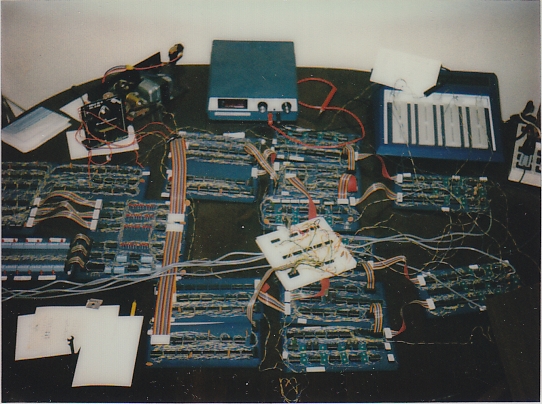
Here's a rather longer composition I was able to encode in the completed machine and imaginatively titled "Concerto 1978." There must have been a score for this, but it hasn't turned up. Some notes I made in 1979 indicate that the first movement was composed in October and was supposed to have synthesizer accompaniment.
Concerto 1978: 1st Movement (25:40)
The second movement — which no longer exists in any form — was composed in August for solo piano. (By this time I had a real piano in my apartment — a Baldwin upright — but apparently I didn't have any microphones.) The third movement was also supposed to have synthesizer accompaniment. There was some damage to the tape on which this was recorded.
Concerto 1978: 3rd Movement (15:14)
Eight days later I recorded "Midnight Circus," which I had composed and programmed into the sequencer in a week.
Midnight Circus (12:36)
Considering that everything had to be programmed into this machine by manipulating tiny switches, I'm surprised I did so much on it. I have two more examples of the Four-Channel Sequencer, but both are unfinished. This one was recorded on March 23, 1979:
Unfinished Composition, 3/23/79 (6:07)
The second was recorded June 3, 1979, and also suffered some tape damage:
Unfinished Composition, 6/3/79 (15:12)
Sometime while working on enhancements to this device, I thought it might be useful to encode numbers that were neither notes or references to notes, but codes that would tell the hardware what to do. I had the idea of storing these codes in memory, and then having circuitry that would respond to particular codes, and I remember very distinctly the moment one evening when I suddenly realized that I was reinventing the computer.
This realization gave me permission to start considering using microprocessors for future music synthesizers, and I began disassembling the sequenzer. It had much too large a footprint, and I knew I would need the parts for something much more ambitious, and which I was already designing.
The Digital Electronic Music Synthesizer
Sometime in 1977 (I suspect), at a local store called Computer Mart, I bought a copy of Computer Music Journal, Volume I, Number 2 (April 1977). This was a fascinating issue. The lead story was "Design of a Digital Oscillator which will Generate up to 256 Low-Distortion Sine Waves in Real Time" by John Snell. There were a couple related articles, and also a reprint of John M. Chowning's classic article "The Synthesis of Complex Audio Spectra by Means of Frequency Modulation."
Up to this time, I was controlling notes using digital hardware but not getting involved in the generation of the actual tones. The concept of the digital synthesizer described by John Snell was revelatory to me.
The idea is to generate sine curves digitally. At the time, computers — or at least the type of computers that people could afford — weren't fast enough to do this in software. So you move the job to hardware. In the center of the digital synthesizer is a Read-only Memory (ROM) storing values of the sine function. This ROM is accessed at a constant sampling rate (about twice the highest frequency you need to synthesize) incrementing the address with a factor that is proportional to the desired frequency. Yet another article in that second issue of CMJ ("Table Lookup Noise for Sinusoidal Digital Oscaillators" by F. Richard Moore) described the math involved to get the digitization noise down to a tolerable level.
After generating the sine curve digitally, it must be multiplied by an amplitude. (The multiplication turns out to be the most time-consuming part of the process.) The result is sent to a Digital-to-Analog Converter (DAC) which converts it into a voltage.
Of course, one sine curve would be boring, so you need to construct the synthesizer so that multiple sine curves are generated simultaneously. Because generating each sine curve is a series of steps (incrementing the phase angle, accessing the sine curve ROM, multiplying by an amplitude, accumulating with other sine curves), the hardware is constructed as a pipeline, so that while one sine curve is undergoing multiplication by the amplitude, the next sine curve is being accessed from the ROM.
As the title of John Snell's article indicates, in theory 256 sine curves could be generated simultaneously. You could then separate them into groups of 16 (or so) so that the sine curves in each group represented harmonics of a particular tone, and you could generate a complex waveform in a process called "additive synthesis." If you were generating 256 since curves, you could then generate 16 synthesizer voices simultaneously.
Or, you could modulate the frequency of one sine curve by another sine curve to generate complex waveforms. This is John Chowning's famous technique of frequency modulation (FM) synthesis. Unknown to me at the time, John Chowning had patented the process and sold the rights to Yamaha. But it didn't matter because I wasn't interested in creating a commercial product. I just wanted something for myself. Simple FM synthesis seemed the best approach to generate as many simultaneous sounds with as few sine curves as possible.
Of course, you'll also need a computer to control the digital synthesizer, and to me that meant I'd need to build a computer. At the time, the two most popular 8-bit microprocessors were the Intel 8080 and the Motorola 6800. I also seriously investigated using an early 16-bit microprocessor, the Texas Instruments TMS9900.
But I put off that decision and began the project with a stand-alone "TV typewriter," which let me type on a keyboard and have the characters be stored in memory and appear on a black-and-white monitor. This photo is dated July 15, 1979, and shows a TV set converted into a video display capable of displaying 16 rows of 32 characters each:
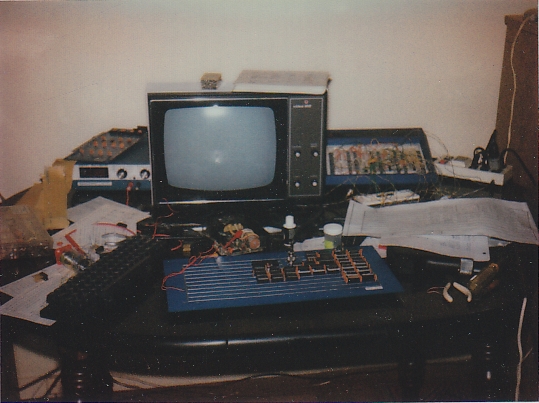
Everything was wire-wrapped. I loved wire-wrapping. I would make little labels for the bottom for the circuit board for each IC socket, and I'd have a hand-written wire-wrap list ready, and I'd just go at it. I found the process very relaxing.
Another early part of the project was building a system involving a 5-octave keyboard (which I immediately had to modify after purchasing it) mounted in the case from my old Univox piano. I cut a piece of sheet metal to fit a typewriter keyboard, 32 potentiometers, four joysticks above the typewriter keyboard, and 8 two-digit hexadecimal slide switches. This photo is dated July 22, 1979:
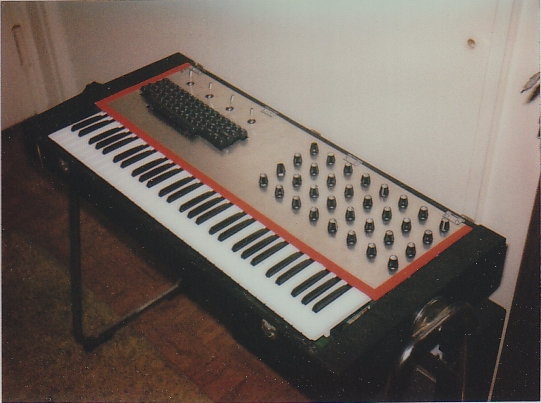
Seeing this, people would always ask what the dials were for. Well, they were "soft" dials. Hardware inside the case constantly polled the values of the joysticks and potentiometers by passing them through an analog-to-digital convertor. Later on, the dials mostly defined envelopes of of the frequencies and amplitudes of the modulating and carrier waves involved in a particular FM voice. Here's how it looked on December 12, 1979:
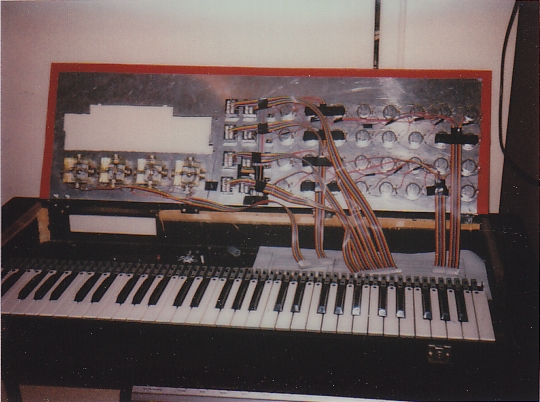
Each key of the keyboard was also digitally sampled, allowing full polyphony.
This thing took a long time to build because I could only afford to spend about $100 a month. Most of that money was sent to companies on the west coast, in particular Jameco and Jade. I would spend the interim months designing and redesigning the circuitry. I got the computer working in early 1980:
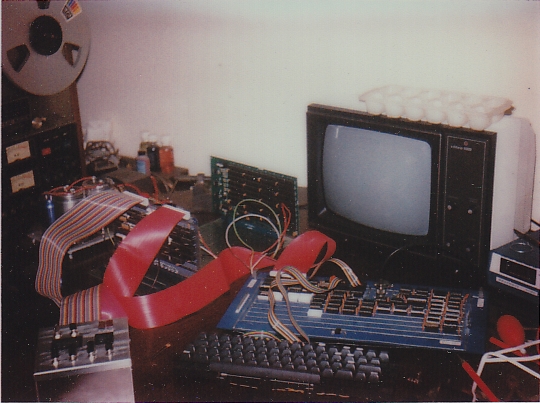
I had finally settled upon the 8-bit Zilog Z-80 chip, which had a superset of the instruction set of the Intel 8080. I made a little box (shown in the lower-left corner of the photo) that let me manually control the Z-80. I could stop the microprocessor from running, let it go, or reset it. Also on the box are four hexadecimal rotary switches to dial in an address, and two more to dial in a byte. This is how I was able to enter machine code into memory. A pair of hex displays let me view bytes in memory.
In this way I would enter enough code that would then allow me to type further byte sequences from the keyboard into the TV-typewriter part of the setup.
By May 1980, the computer part of the project was really coming together:
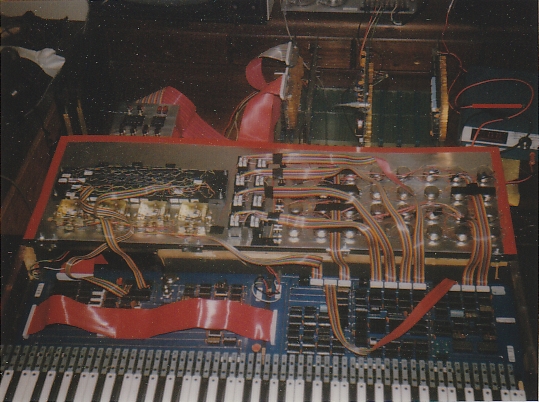
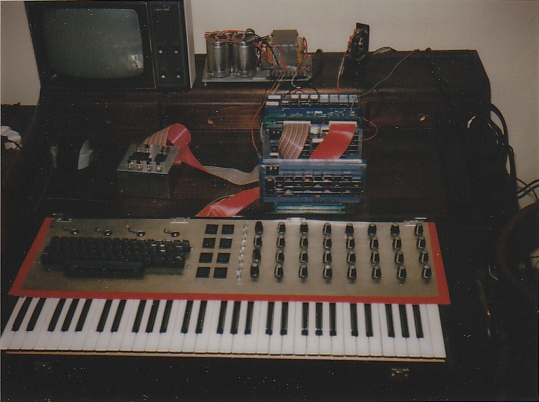
A power supply is to the right of the monitor. Eventually I had two of those. The S-100 motherboard with the blue boards is the computer part. Eventually I had another for the synthesizer.
I don't have many more interim photos. By April 1981, I was able to use the music keyboard to play FM voices with envelopes applied to the carrier and modulator amplitudes and frequencies, and by August 1981 all the software was written to store and playback entire compositions.
These photos from June 1982 show the digital synthesizer in its final form:
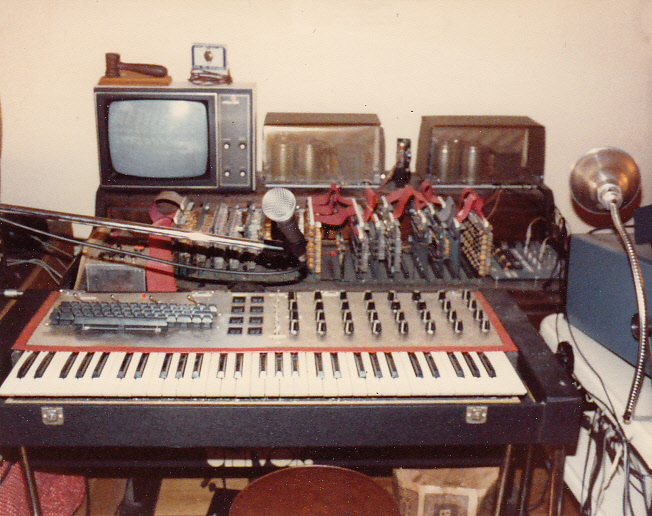
Much of it is on a wooden desk. On the raised portion at the rear to the right of the monitor are the two power supplies. On the surface of the desk from left to right is the box used for manually entering bytes into memory, the S-100 motherboard for the computer, the S-100 motherboard for the synthesizer (which required cables to funnel data through the pipeline from one board to the next), and a board with the digital-to-analog convertors and audio output.
Here's a broader view:
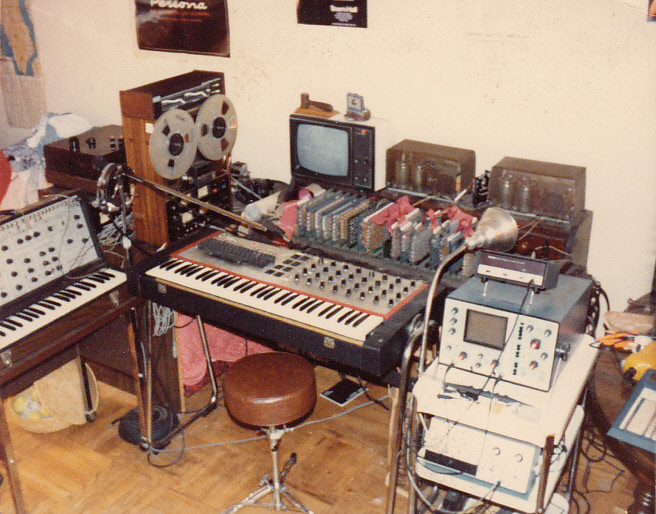
Notice the TEAC 3340S to the left. A graphic equalizer sits on top. (Behind it is my stereo system; you can see the turntable cover.) To the far left is the ElectroComp 101. To the right of the keyboard unit is a steel tray on wheels with a Heathkit oscilloscope I assembled, and below that I believe is frequency counter. To the right is the wooden oval dinner table used as a workbench.
This photo is the same except showing some of the posters on the wall, including a Philip Glass concert, a Steve Reich concert, and my favorite movie at that time, Persona.
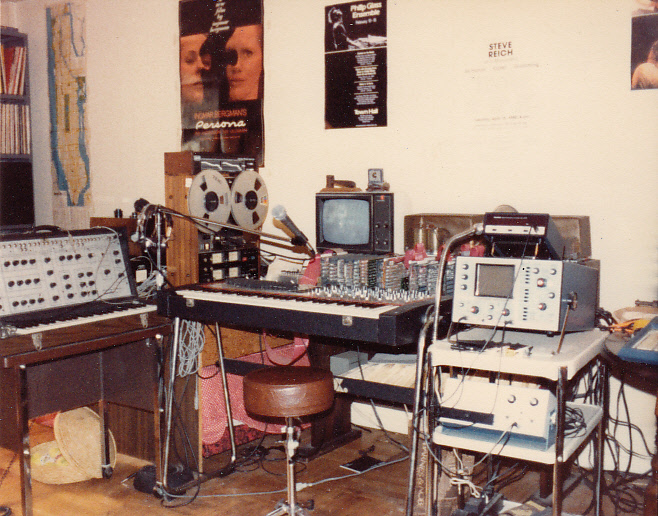
Turning 90° to the left, you can see the windows in my apartment overlooking Broadway, flanked by steel shelving containing my LP collection and a pair of Polk speakers. My bed is to the left. (Yes, this is a studio apartment.) The edge of my piano can be seen at the far left. Little Cat is on the floor.
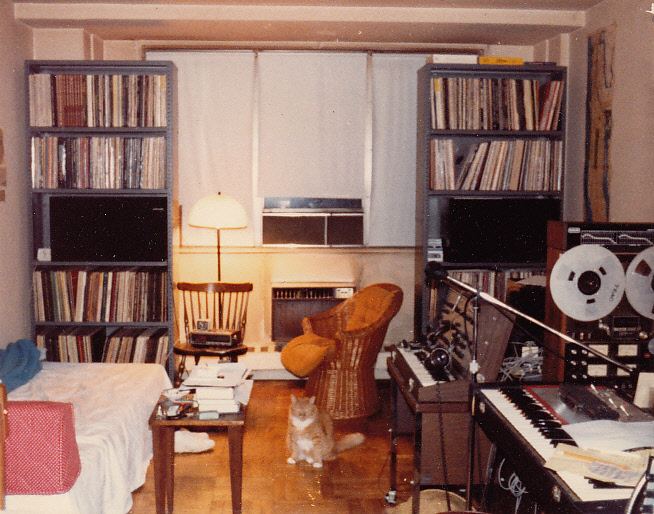
The synthesizer in its final form was capable of generating 80 simultaneous sine waves, combined in pairs for simple FM synthesis of 40 tones at a sampling rate of 31,250 Hz. For the multiplication of the sine curve values by the amplitude, I used a massive 64-pin TRY MPY16HJ chip, which could perform a 16-bit by 16-bit multiplication in 50 nanoseconds. (How fast can the microprocessor in your desktop computer perform a 16-by-16-bit integer multiplication?) This dedicated multiplier chip cost $241.
I later wrote an 80-page document that describes this digital synthesizer, the computer that ran it, and the Music Programming Language that I invented to encode compositions. (This document is available in Appendix II.) The purpose of this document was to give to people who might recognize my obvious genius and hire me away from New York Life Insurance Company.
Here's what I looked like at the time. I was 29 years old.

Songs? You Can't Sing and You're Writing Songs?
By August 1981 the MPL interpreter was working and I was ready to start programming and playing back compositions.
As the Digital Synthesizer became ready for actual use, something very strange happened: I started writing songs. I'm not sure why. I certainly knew then — as I still know now — that I can't sing a lick. But whatever tunes were going through my head at this time, they were accompanied by lyrics, so there was really nothing else I could do. The core of most of these compositions consisted of programmed sequences simply played back by the computer controlling the digital synthesizer, but once I got them on tape, I could add additional tracks for voice, hand-played synthesizer, and sometimes piano.
The first of these songs was completed and recorded in early September, 1981, and seems to describe some kind of primitive ritual. I sure didn't make it easy for myself. There are way too many words per line to fit into the bars I allowed for them.
Worship the Stars (6:10)
As you can hear, I was able to get some good klanging percussive sounds out of the synthesizer as well as more typical electronic sounds.
For the songs of this period, I still have my typed or handwritten lyrics. For both songs and non-songs, I have a hand-written listing of the Music Programming Language (MPL) used to play back the music. These are reproduced in Appendix I. MPL is documented in Appendix II. There is no documentation of the instrument patches.
Perhaps I wanted to back off from singing, for the next one has spoken lyrics. It's based on a true story. When I was about 10 or so, my family went to some amusement park type of place and as we were ready to leave around sunset and walking to the car, my little sister disappeared. There was a body of water nearby, and it was getting dark and windy, none of which helped my mother's state of mind. (My sister later turned up safe and sound.)
I Can't Find Them. Where Are They? (2:52)
In the next song, I was back to singing, unfortunately. This one began with the lyrics "Do you know what I mean / When I say that the scream / is the profoundest form of expression? / Just ask Edvard Munch / When he's over for lunch / About his compelling obsession" and goes downhill from there. Such lyrics would lend themselves best to a Gilbert & Sullivan-like patter song, but I insisted on slowing it way down and actually trying to sing a glissando.
But I like the bell sound at the beginning.
The Scream (7:04)
I then did an instrumental. I'm sure at the time the title "The Six Mountains" made sense; I do not know what it means. It might be about sounds getting louder and softer over time.
The Six Mountains (4:06)
I believe the chart that's included with the score is a calculation of logarithmic volume progressions.
Those first four pieces were programmed and recorded in September 1981. In early October I first recorded "Flowing with the Flow," which has a considerable amount of piano, as well as demonstrating some of the sound density I could achieve with 40 simultaneous FM voices. I later made a couple other versions; this is actually the third version from January 1982:
Flowing with the Flow (4:31)
In 1981, if you wanted to know the exact time, you would make a phone call, and if you wanted, you could listen to the time announcement for at least several minutes. I think I thought it would be challenging to synchronize some music with that. This was completed on October 11, 1981:
Bulletin (4:06)
I was going to suppress this next one because — well, for obvious reasons. But then I listened to it and it made me laugh, and it's mercifully short. The song is based on two true incidents that I combined out of, umm, poetic license. At that time I really was a big fan of Sara Lee Fudge Swirl Pound Cake, which I would put in my toaster oven to give the cake a nice layer of crispiness and melt the chocolate a bit. Sometimes I'd put a piece in, get distracted, and it would burn to a crisp. But it wasn't really the piece of Sara Lee Fudge Swirl Pound Cake that set my kitchen garbage on fire. It was a hastily emptied ashtray. The song was recorded on November 15, 1981.
Slice of Sara Lee (2:07)
These days, of course, it is considered improper to suggest any sort of sexual attraction to a teen-age advertising icon, but I guess that was a different era.
This one — which I couldn't decide whether to call "Ambivalence" or "Ambivalent Feelings" — was recorded November 23, 1981. It actually seems to swing a bit:
Ambivalent Feelings (5:04)
A couple months passed. In mid-February 1982 I recorded a long composition, not a song, based almost entirely on a single arpeggio, and experimenting with the effect of overlapping voices fading in and out. Occasionally you'll hear what sound like single intrusive notes that don't belong. These are software glitches — some kind of nasty bug that I was never able to find.
Out of the Woodwork (25:15)
I really hate this one (called "Falling Back" and recorded March 27, 1982), but it has some cool sounds here and there:
Falling Back (4:24)
The last song I wrote is called "Someday," and it's the one I'm proudest of. I like the tempo, I like the pacing, and my voice actually sounds reasonable. It was first recorded on April 11, 1982, but I later tried re-mixing it to make my voice sound better.
Someday (7:20)
This final composition is a conceptual piece of process music basic on Bach's Fugue in C Minor from Book 1 of The Well-Tempered Clavier. The fugue is played "straight" at the beginning and end. In between, you hear a one-bar "window" of the fugue repeated four times before it moves ahead a beat. This was recorded May 20, 1982.
Bach/Petzold: Fantasy on a Fugue (43:45)
At some point I'd like to write a program that plays "Fantasy on a Fugue" using FM voices generated in software but letting the user interactively select tempo, instrument sounds, and the number of repetitions. Perhaps Windows 8 is a good platform for this program.
ADDENDUM: Rather than Windows 8, in August 2024 I used the Web Audio API to realize this long-delayed dream. The results are available (and listenable and manipulable) in my blog entry “Fantasy on a Fugue” (Revisited).
The Silence of the Tunes
I originally started messing around with making electronic music instruments because I heard tunes in my head that I wanted to hear for real. Sometime in 1982, the tunes stopped, and they've never come back.
Still, I knew that what I had built was not quite normal, and I wrote the document in Appendix II to describe it. That document is dated December 1983. It was created on my first "store bought" computer, an Osborne 1 (shown below). My word processor was the CP/M version of WordStar and I printed the document on a daisy-wheel printer (foreground):
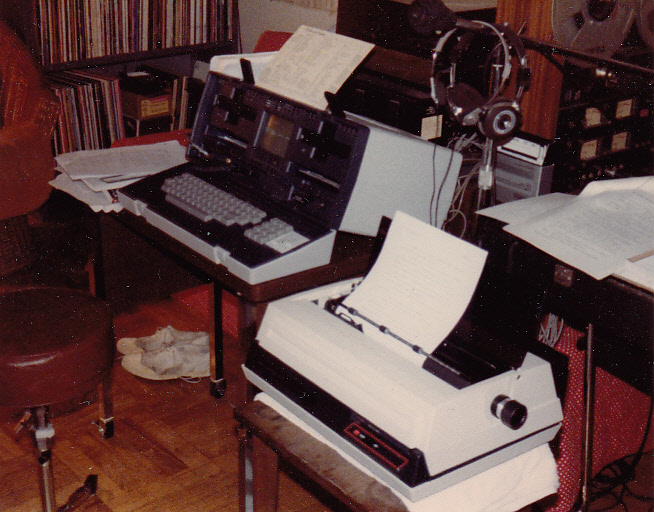
I added the diagrams by hand.
The next month (January 1984) I wiped out three credit cards by spending $5,000 buying my first two-floppy monochrome-display IBM PC. I realized I'd need to make it earn some money, so I wrote an article on MS-DOS and the Prompt command and sent it to PC Magazine, and they paid me $650 for it. By June 1985 I was able to quite my job at New York Life Insurance Company and begin my freelance career.
Although I had some plans to control the Digital Electronic Music Synthesizer from the Osborne 1 or the IBM PC, I was really off in another direction in my life. I progressively dissassembled the computer and synthesizer, and kept all the circuit boards in boxes, but when it became clear that I'd never put it back together, much of it was thrown away.